Texas Tree Tips – May, 2011
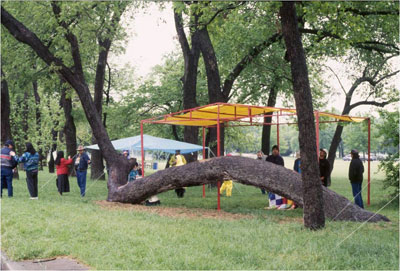
Gateway Park Indian Marker Tree. Photo courtesy of Doug Taylor.
Indian Marker Trees, Part 2
The purpose of discussing Indian marker trees in a public forum is to increase awareness of their existence and to recognize them as living witnesses to our history, as well as priceless cultural treasures. (Click here to read Part 1.) Indian marker trees should be celebrated, preserved, and properly maintained to ensure that future generations have an opportunity to enjoy them. All trees are lost over time. Therefore, recognizing them beforehand seems to be a moral obligation. In addition, the elders who have knowledge of Indian marker trees within the various tribes around the nation will not be around forever, and any remaining knowledge of these trees must be recorded. We cannot preserve significant trees or cultures that we have not taken the time to recognize or fully understand.
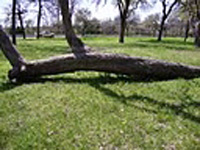
California Crossing Marker Tree, courtesy of Bill Seaman.
According to tribal elders of various Indian nations, individual tribes had different styles of selecting and bending marker trees. For example, Indian marker trees found in Florida may be from the Seminole tribe, while trees found in Alabama may be Choctaw or Chickasaw. The form and function of individual trees can vary considerably, but all of them served an important purpose that may not be clear without researching the surrounding area for clues and checking with various experts. As an example, the California Crossing Marker Tree, in Dallas, signified a good area to cross the Trinity River in shallow water, an important fact to know many years ago (unless you needed a bath).
The California Crossing Marker Tree has been blessed by tribal elders, and the Gateway Park Marker Tree (noted in last month’s article) was officially recognized with a proclamation from the Comanche nation on April 26, 1997. (See the proclamation here). The proclamation notes that the site was a favored campground due to the abundant resources in the area.
Ironically, the entire top of the tree was broken off just above the long bend during a subsequent Memorial Day storm. A section of the tree was preserved and used to date the age of the tree, which was over 500 years old. In addition, an unsuccessful effort was made to revive the tree by planting saplings near the base and grafting the top growth into the trunk of the tree.
Guidelines to help distinguish between what may or may not be Indian marker trees are currently being developed for the North Texas area. A few important points include the following:
They must be at least 150 to 200 years old. Quantifying their age will be the subject of a future article. Unlike humans, trees can`t hide their age. (Glad you’re not a tree?)
They are always a native tree species that is known to be long-lived for the given part of the country. Without a doubt, the Indian tribes were quite knowledgeable about the life expectancy and cultural habits of tree species.
They often include sharp bends in the trunk, which would have required an acute knowledge regarding the biological function of a tree’s vascular system. To create the bend, often called a “hip,” may have required the removal of bark and underlying tissues. If any of the bends in the trunk are higher above ground level than a person could have created from standing on the ground, the tree may not be an Indian marker tree.
They are often associated with significant natural features, such as a tree recently submitted in Bowie, which marks a natural spring.
They are often associated with witness reports and with records indicating that arrowheads or other artifacts were once found in the area.
They may show injury scars along the trunk, resulting from the thongs that tied them down, or possibly wounds created to maintain their bend.
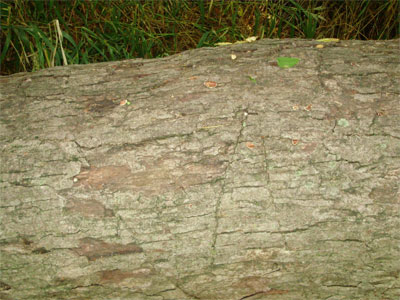
Trunk scars, courtesy of Steve Houser.
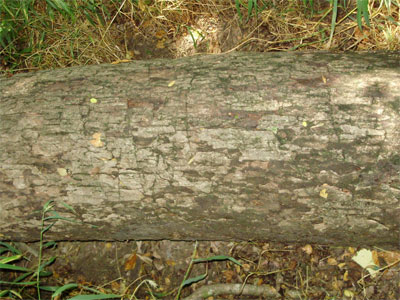
Trunk scars, courtesy of Steve Houser.
In contrast, trees that are not Indian marker trees, though they may exhibit a similar bend, are typically trees that are blown over, or forced over by ice and snow accumulations. These trees will often show exposed roots on one side of the trunk and a mound of soil created when the roots have been forced upward and the trunk has gone over.
To the skeptics who say nature, not Indians, created these trees, I would pose a simple question: How could nature create two such trees near each other (termed “doublets”) or even three trees close together?
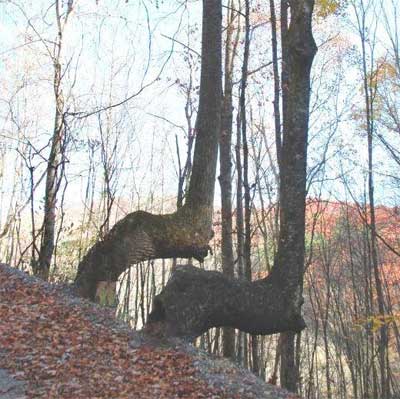
Doublet, courtesy of the Mountain Stewards.
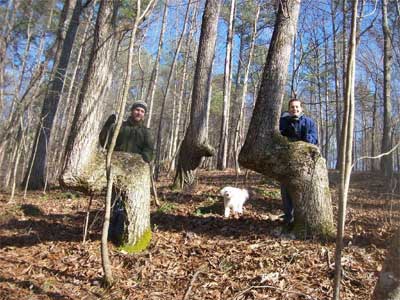
Triple trees, courtesy of the Mountain Stewards.
The Indian Nations understood, celebrated, and lived in complete harmony with all aspects of our natural world. They were the ultimate stewards of our lands and they understood the importance of maintaining a healthy balance in any ecosystem — something we should carefully consider in determining how we live in the future.
Resources:
www.Mountainstewards.org
www.DHTC.org
www.Texastreetrails.org
About the author: Steve Houser is a Dallas native with more than 30 years of experience as a consulting arborist and tree climber. He is the president of Arborilogical Services Inc., “The Experts Your Trees Deserve.” www.arborilogical.com.

